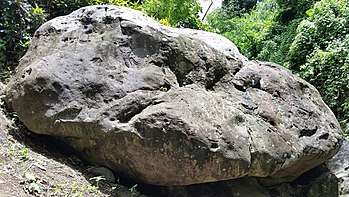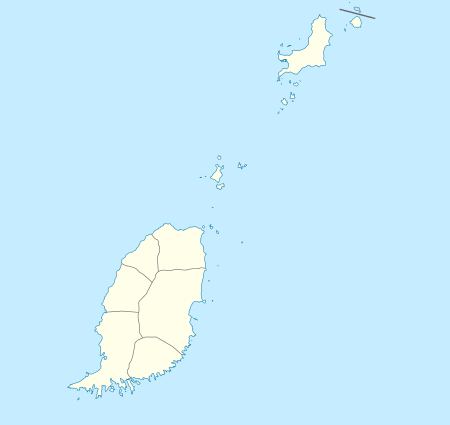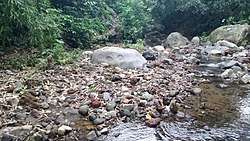Mt. Rich Petroglyphs
The Mt. Rich Petroglyphs are a series of pre-Columbian petroglyphs, set deep in a ravine along the Saint Patrick River in Mt. Rich, Grenada. The site consists of several boulders, the largest of which contains over 60 engravings.[1] Two "workstones" can also be found nearby, comprising six cupules.[2]
 Main stone at the Mt. Rich Petroglyphs | |
 Shown within Grenada | |
| Location | Mt. Rich, St. Patrick Parish, Grenada |
|---|---|
| Coordinates | 12°11′36.28″N 61°38′34.47″W |
| Type | Petroglyph |
| History | |
| Periods | Troumassoid Period (AD 700-1650) |
| Cultures | Indigenous peoples of the Caribbean |
| Site notes | |
| Ownership | Mixed public and private |
| Public access | Yes |
History
Given the diversity and sheer number of images (which may be well over 60),[1] some researchers have hypothesized they represent a palimpsest of drawings carved at different times. For instance, a study of the design elements in the Mt. Rich petroglyphs, as compared to others in the Lesser Antilles, found that the earliest images at Mt. Rich may have been carved as early as AD 500.[3] Ceramic data from a nearby archaeological site suggests they were carved slightly later, perhaps as early as AD 700. [4][5]
.png)
The earliest historical reference to the Mt. Rich stones is a brief note dated 1845 in Simmond's Colonial Magazine, which describes "several hieroglyphical characters" carved on a stone below the Mount Rich sugar‐works.[6] In 1921, Thomas Huckerby, a Methodist minister that previously wrote an article on St. Vincent's petroglyphs,[7] published a small booklet about Grenada’s petroglyphs through the Museum of the American Indian in New York (now part of the Smithsonian).[8] The 1921 report contains photographs and discussion of the glyphs at Mt. Rich and two other sites near Victoria, Grenada. Since Huckerby's visit, several researchers have mentioned the site in their reports.[9][10][11][5][4]
In 1986, Archaeologists Ann Cody and Thomas Banks recorded Mt. Rich in an inventory of the island's prehistoric sites.[10] They observed that Huckerby's photographs did not match the current position of the main stone, leading them to hypothesize that the rock had rolled down the hill after Huckerby’s visit. Others have since noted that, given its association with the other petroglyphs and workstones in the river, the main stone likely just moved slightly out of position since 1921, perhaps a result of people standing on top.[5] Indeed, the 1845 article describes the stone as situated below the Mt. Rich sugar estate, indicating it was always in the ravine.
Interpretation

While the original meaning of the Mt. Rich engravings can only be speculated, archaeologists have made several observations about rock art in the Caribbean, generally:[12]
- they always occur near water
- there are often "workstones" nearby
- some images occur on ceramics, but most do not
- there are three general categories: simple faces, elaborate faces, and geometric patterns
- the elaborate faces often have zoomorphic (animal-like) features
Most Caribbean archaeologists hold that petroglyphs were drawn by shamans, perhaps to denote places where ancestors would gather.[13] Like much of the New World, Amerindian groups in the Caribbean were animists, and sought to communicate with their ancestors. If petroglyphs are ritual spaces, then the accompanying workstones may be mortars upon which the shamans mixed hallucinogenic concoctions to connect with the ancestors before carving (or re-carving).[14]
Visiting
In 2014, a local youth group (MYCEDO) received a grant to renovate an old lookout building and turn Mt. Rich into a heritage attraction.[15] In 2018, they opened the building to visitors, offering information and a viewing platform for a small fee. The group also conducts tours of their village and the abandoned plantation estates nearby.[16]
The Mt. Rich Petroglyphs are part of the Ministry of Tourism's Petroglyph Path tour, which links several of Grenada's rock art sites.[17]
Related
References
- "Mt Rich Grenada (Caribbean)". Megalithic Portal. July 7, 2010. Retrieved 15 January 2018.
- Allen, Casey; Groom, Kaelin (2013). "Evaluation of Grenada's "Carib Stones" via the Rock Art Stability Index". Applied Geography. 42: 165–175. doi:10.1016/j.apgeog.2013.02.007.
- Jonsson Marquet, Sofia (2009). "Contextual Analysis of the Lesser Antillean Windward Islands Petroglyphs". In Hayward, Michele H.; Atikinson, Lesley-Gail; Cinquino, Michael A. (eds.). Rock Art of the Caribbean. Tuscaloosa: University of Alabama Press. pp. 147–160. ISBN 9780817355302.
- Petitjean Roget, Henry (1981). Archaeology in Grenada. Barbados: Caribbean Conservation Association. OCLC 499476858.
- Hanna, Jonathan (2017). The Status of Grenada's Prehistoric Sites: Report on the 2016 Survey and an Inventory of Known Sites. Botanical Gardens, Grenada. pp. 161–164. doi:10.18113/S1QG64.
- Antiquarian (1846). "Relics of the Charib Indians in the Island of Grenada". Simmond's Colonial Magazine and Foreign Miscellany. VII (January–April).
- Huckerby, Thomas (1914). "Petroglyphs of St Vincent, British West Indies". American Anthropologist. 16 (2): 238–244. doi:10.1525/aa.1914.16.2.02a00040.
- Huckerby, Thomas (1921). Petroglyphs of Grenada and a recently discovered petroglyph in St. Vincent. Indian Notes and Monographs. 1. New York: Heye Foundation, Museum of the American Indian.
- Bullen, Ripley P. (1964). The Archaeology of Grenada, West Indies. Contributions of the Florida State Museum: Social Sciences. Gainesville: University of Florida. OCLC 495548996.
- Cody, Ann (1986). Archaeological Site Records. St. George’s, Grenada: on file at the Grenada National Museum.
- Dubelaar, C.N. (1995). "Grenada". The petroglyphs of the Lesser Antilles, the Virgin Islands, and Trinidad. Amsterdam: Natuurwetenschappelijke Studiekring voor het Caraïbisch Gebied. pp. 46–89. ISBN 978-90-74624-05-3. OCLC 905778960.
- Hayward, Michele H.; Atikinson, Lesley-Gail; Cinquino, Michael A., eds. (2009). Rock Art of the Caribbean. Tuscaloosa: University of Alabama Press. ISBN 9780817355302.
- Wild, Kenneth (2003). "Defining Petroglyphs from the Archeological Record" (PDF). Proceedings of the XXI International Congress for Caribbean Archaeology. Santo Domingo, Dominican Republic: IACA. Retrieved 16 January 2018.
- Pagan-Jimenez, Jaime R.; Carlson, Lisabeth (2014). "Recent archeobotanical findings of the hallucinogenic snuff Cohoba (Anadenanthera peregrina (L.) Speg.) in precolonial Puerto Rico". Latin American Antiquity. 25 (1): 101–116. doi:10.7183/1045-6635.25.1.101.
- "MAREP Conducts Training". NowGrenada. 13 November 2014. Retrieved 16 January 2018.
- "MYCEDO". Retrieved 16 January 2018.
- "Petroglyph Path". Retrieved 16 January 2018.